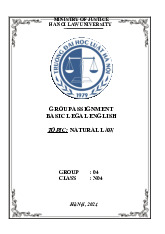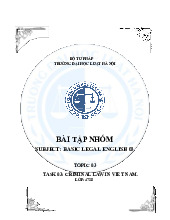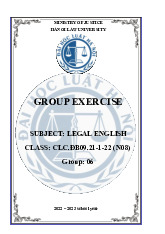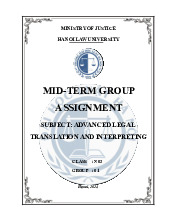













Preview text:
lOMoAR cPSD| 58412604 UNIT 4
LEGAL SYSTEMS IN THE WORLD
Discuss these questions with a partner 1. Lead-in What is legal system?
2. Can you name the legal system of some countries in the world?
SECTION I: AN OVERVIEW INTO LEGAL SYSTEMS IN THE WORLD READING COMPREHENSION Exercise 1:
Answer these questions, then read the article below to check your answers
1. How many main legal systems are there in the world?
2. What are the differences among these main legal systems?
3. Where are these main legal systems originated from?
4. What is the legal system of your country?
5. What does the legal system often reflect?
Reading 1: Three legal traditions
A legal system is an operating set of legal institutions, procedures, and rules. National legal
systems are frequently classified into groups or families. Thus, the legal systems of England, New
Zealand, California, and New York are called “common law” systems. Similarly, France, Germany, Italy,
and Switzerland have their own legal sytems, as do Argentina, Brazil, and Chile. It is true they are all
frequently spoken of as “civil law” nations. But it is inacurate to suggest that each group has identical
legal institutions, processes, and rules. On the contrary, there is great diversity among them, not only
in their substantive rules of law, but also in their institutions and processes. For example, although all
land in the Soviet Union is owned by the state, most other “socialist law” nations permit some private
ownership of land. There is no such thing as the civil law system, the common law system, or the
socialist law system. Rather, there are many different legal systems within each of these three groups or families of legal systems.
A legal tradition is not a set of rules of law about contracts, corporations, and crimes, although such
rules will almost always be in some sense a reflection of that tradition. Rather it is a set of deeply
rooted, historically conditioned attitudes about nature of law, about the role of law in the society and
the polity, about the proper organization and operation of a legal system, and about the way law is or
should be made, applied, studied, perfected, and taught. The legal tradition relates the legal system
to the culture of which it is a partial expression. It puts the legal system into cultural perspective.
There are three highly influential legal traditions in the contemporary world: civil law, common law, and socialist law.
Of the great variety of living legal traditions, the three mentioned above are of particular
interest because they are in force in powerful, technologically advanced nations and because they
have been exported, with greater or less effect, to other parts of the world. Of the three, the civil law
tradition is both the oldest and the most widely distributed. The traditional date of its origin is 450 lOMoAR cPSD| 58412604
B.C, the supposed date of publication of the XII Tables in Rome. It is today the dominant legal tradition
in most of Western Europe, all the Central and South America, many parts of Asia and Africa, and even
a few enclaves in the common law world (Louisiana, Quebec, and Puerto Rico). It was the dominant
in Cuba and the nations of Eastern Europe – including the Soviet Union – that have become socialist,
and it continues to exercise an important influence on socialist legal systems. Hence an understanding
of the civil law tradition is essential to an understanding of socialist law. It is also difficult to overstate
the influence of the civil law tradition on the law of specific nations, the law of international
organizations, and international law.
The date commonly used to mark the beginning of the common law tradition is A.D.1066, when the
Normans defeated the defending natives at Hastings and conquered England. If we accept that date,
the common law tradition is slightly over 900 years old. It is sobering to recall that when the Corpus
Juris Civilis of Justinian was published in Constantinople in A.D.533, the civil law traditon, of which it
is an important part, was already older than the common law is today. As a result of the remarkable
expansion and development of the British Empire during the age of colonialism and empire, however,
the common law was very widely distributed. It is today the legal tradition in force in Great Britain,
Ireland, the United States, Canada, Australia, and New Zealand, and has had substantial influence on
the law of many nations in Asia and Africa.
The socialist law tradition is generally said to have originated at the time of the October Revolution.
Before that event, the dominant legal tradition in the Russian Empire was the civil law. One intention
of the Soviet revolutionaries was to abolish the bourgeois civil law system and substitute a new
socialist legal order. The actual effect of their reform was to impose certain principles of socialist
ideology on existing civil law systems and on the civil law tradition. Under the influence of the Soviet
Union and Marxist thought, similar legal changes have taken place in those states of Eastern Europe
(and in other countries, such as Cuba) that were parts of the civil law tradition before they became
socialist states. The result is a young, vigorous legal tradition that still displays its essentially hybrid nature.
The socialist attitude is that all law is an instrument of economic and social policy and that the
common law and civil law traditions basically reflect a capitalistic, bourgeois, imperialist, exploitative
society, econnomy and government. Socialists see our legal system as incorporating and perpetuating
a set of goals and ideals that they regard as socially and economically unjust. At the same time, the
common law apprear to a Soviet lawyer to be unsystematic and undeveloped, in comparison with
carefully drawn Soviet legislation that builds on the civil law tradition of system and of order. Finally,
to socialist lawyer, both the civil law and common law traditions are subject to criticism because they
embody but do not clearly state their ideologies. Such a lawyer sees our legal systems as devices by
which bourgeois ideals are concealed in ostensibly neutral legal forms, which are then used to exploit the proletariat. lOMoAR cPSD| 58412604 Vocabulary Legal system (n) Hệ thống pháp luật Legal tradition (n) Truyền thống pháp luật Civil law (n) Dân luật Common law (n) Thông luật Socialist law (n) Luật xã hội chủ nghĩa The XII Tables (n) Luật 12 Bảng
The Corpus Juris Civilis (n) Bản Pháp điển dân sự
The October Revolution (n)
Cuộc Cách mạng tháng Mười Marxist thought (n) Tư tưởng Mác xít Private ownership (n) Sở hữu tư nhân Ideology (n) Hệ tư tưởng Bourgeois (n) Nhà tư sản Proletariat (n) Giai cấp vô sản Unjust (adj) Bất công In force (adj)
Có hiệu lực, đang sử dụng LANGUAGE WORK Exercise 2:
Find nouns or noun phrases in the article that collocate with these verbs 1. exercise ……….. 4. conceal………………… 7. impose ……………….. 2. state ……………….. 5. perpetuate ………….. 8. embody ………………. 3. apply ………………. 6. display ………………… 9. abolish ……………….. Exercise 3:
(a) Match these words to make collocations from the text 1. dominant a. effect 2. hybrid b. perspective 3. cultural c. ownership 4. civil law d. principles 5. socialist e. economy 6. actual f. legal tradition 7. imperialist g. nature 8. private h. system 9. certain i attitudes
(b) Write a sentence using each collocation in context from part (a) 1.
............................................................................................................................................
............................................................................................................................................ lOMoAR cPSD| 58412604 2.
............................................................................................................................................
............................................................................................................................................ 3.
............................................................................................................................................
............................................................................................................................................ 4.
............................................................................................................................................
............................................................................................................................................ 5.
............................................................................................................................................
............................................................................................................................................ 6.
............................................................................................................................................
............................................................................................................................................ 7.
............................................................................................................................................
............................................................................................................................................ 8.
............................................................................................................................................
............................................................................................................................................ 9.
............................................................................................................................................
............................................................................................................................................
(c) Work in pairs. Test your partner on the collocations by giving the first or second part to elicit the other.
e.g. Student A says: take Student B says: place (Take place-V) Exercise 4:
Complete these sentences by choosing the right adverb in the box below
essentially - widely – frequently – basically - deeply
1. The young, vigorous legal tradition still displays its…………. hybrid nature.
2. It is a set of……………. rooted, historically conditioned attitudes about nature of law.
3. National legal systems are ………… classified into groups or families.
4. The common law and civil law traditions …………… reflect a capitalistic, bourgeois, imperialist,
exploitative society, econnomy and government.
5. The common law was very…………… distributed. lOMoAR cPSD| 58412604 Exercise 5.
Work in pairs. Take it in turn to choose one of the words in the box below and define or
describe it for your partner to guess. Try to make a sentence for your partner to guess that word correctly. Legal system In force Common law Unjust Bourgeois Civil law
The October Revolution Private ownership Ideology Proletariat Socialist law The Corpus Juris Civilis
e.g. Student A: This legal term refers to a set of rules, procedures, and institutions by which
public initiatives and private endeavors can be carried out through legitimate means.
Student B: Legal system
Reading 2: The philosophy of Common law and Civil law Exercise 1:
Discuss these questions with a partner
1. What is Common law in terms of its nature?
2. What is the philosophy of Civil law?
3. How is Common law depicted in different aspects?
4. How is Civil law embodied in Family law?
5. What are the differences between Common law and Civil law?
The philosophy of common law
It can be argued that the philosophy of the Common law, the scale of values which it attempts to
express, is one in favour of rights rather than of duties, of emancipation rather than of control, of
responsibility rather than paternalism.
In this connection, a few examples will suffice. But let it be noted that the examples that follow are
chosen because they are in contrast with the traditions of some of the most important Civil law
systems. Thus, in the field of property the Common law is endowed with a most sophisticated system
of rights, which gives to the citizens a tremendous degree of choice. Freehold land exists side by side
with leasehold land and, through the institution of the Trust, there is hardly any legitimate wish of the
citizen which cannot be satisfied. Common lawyers are familiar with other features of the Common
law of property, to the extent that it bears upon the law of succession. Thus, civilians may wonder at
the freedom and ease with which successors may be appointed after the death of a testator through
the exercise, by a third party, of a power of appointment. In the field of succession proper, if the
Common law has erred it has been on the side of rights, by permitting the testator to dispose of his
property without the control of his family and, if he so wishes, to the disadvantage of his family. In
the law of Contract, remarkable is the absence of general clauses that could upset an agreement
between the parties. It is this aspect, combined with what one may almost describe as a doctrinaire
attachment of the Common law to precedents of definition of words and phrases, as well as to the lOMoAR cPSD| 58412604
grammatical interpretation of statutes, that has made the Common law a most efficient instrument
of commercial exchange, frequently resorted to even by those who have no connection with England.
In the field of Tort, there is still a reluctance to impinge on the rights of the individual for the sake of
social realities. The principle of fault still predominates, and the principle of strict liability is severely
limited. Last but not least, in Family law the insistence upon individual rights is expressed in the dislike
for joint family property regimes, in the absence of an obligation to appoint a guardian of an infant
unless there is property involved, and in the early recognition of the right of the young to leave home, set at the age of 16.
The philosophy of civil law
It can hardly be denied that, in some aspects, the Civil law tends to be paternalistic. This is not
necessarily to decry paternalism, for we are all familiar with the utopian view that society consists of
fully fledged adult, responsible and responsive individuals. In the field of human relations, in which
the State does not wish to punish but to regulate life, it can be argued that the Civil law carries a
strong element of paternalism.
Thus, in the law of property and succession, which can only be segregated with difficulty, the Civil law
tends to stress the rights of the family against its individual members. The law insists upon the duty
of the owner of property and of the testator towards his family. For example, many Civil law systems
have rules which oblige the testator to leave - through the compulsory share or legitimate portion -
part of his property to his children, even though they may be grown-up, wealthy and capable of
looking after themselves. There are also rules which prohibit the owner of property to resort to what
his family and the Court may consider abusive disposal of his property. In family law parents exercise
a greater control over their children and for longer-until they reach the age of eighteen, twenty or
even twenty-five. They may refuse their consent to a young marriage and this refusal - as is the case
in French law-may not be overruled by a Court. Parents may also use their children's own income
whereas guardianship and, sometimes, a family council are set up to ensure proper control. The
parents themselves are bound, in their turn, to a form of accounting to the Courts. A joint family
property regime often comes into operation upon marriage and there are many complicated rules
imposed by the law to ensure that such a property or fund is administered in accordance with
principles recognised by the law. In the law of contract, general principles ensure that the freedom of
the parties to enter into any contractual arrangement they wish is limited by the existence of general
clauses. These permit the Court to interfere ex post facto with the wishes of the parties, as expressed
when the contract was made. In other cases, the Courts assume wide powers to interfere or adjust
contracts to new circumstances. In tort there is a greater readiness to accept strict liability and
presume fault. For instance, strict liability exists in most systems in respect of motor accidents. On the
whole, it may be argued that the Civil law interferes more with individuals, expects a higher standard
of behaviour from them than the Common law does, and insists upon the need for discipline and
control. With this view goes an extensive civil power given to the police to regulate behaviour, only
allowing individuals a right to dispute police action after the event. Thus, the police may impose a
ruling on my neighbour, say, on noise, without trial and it is up to him to seek the protection of the lOMoAR cPSD| 58412604
Court. This is often desirable, but it contrasts strongly with the Common law's insistence that the
police should have no greater power than that of any individual. It is not surprising that English
lawyers (and I suspect businessmen) are strongly critical of such exercise of arbitrary power. Vocabulary Philosophy (n) Triết học, triết lý Emancipation (n) Sự giải phóng Paternalism (n) Chế độ gia trưởng Freehold (n)
Quyền sở hữu hoàn toàn về một tài sản trong một thời gian không hạn định Leasehold (n)
Quyền đối với bất động sản bằng hợp đồng thuê Law of succession (n) Luật thừa kế Doctrinaire (a) Giáo điều Liability (n) Trách nhiệm pháp lý Fully-fledged (a) Có đầy đủ tư cách Duty (n) Nghĩa vụ Owner (n) Người sở hữu Legitimate portion (n) Kỷ phần Ex post facto (a) Hồi tố Presume fault (n) Lỗi phải thấy trước Arbitrary (a) Tùy tiện, chuyên quyền Exercise 2:
Use the information in the text to answer the questions below
1. Which field of law is NOT mentioned to illustrate the philosophy of Common law?
A. Family law B. Tort law C. Criminal law D. Contract law
2. What does Common law try to express, the rights or the duties?
3. Which legal system is assumed to convey a strong element of paternalism?
4. What does the number 16 in the text refer to?
5. In what circumstance is strict liability frequently applied? Exercise 3:
Read the text again and complete the following sentences
1. …………………..gives citizens a lot of rights and chances to enjoy their rights in the field of property.
2. ………………….may exercise the power of appointment of who will become the heir in the Common law of property.
3. …………………usually takes precedence over the principle of strict liability in the field of Tort in Common law.
4. ……………..requires civilians to have disciplines and seriously obey the rules.
5. .................have rules which oblige the owner of property to leave part of his property to
his children even though they are mature and fully independent. lOMoAR cPSD| 58412604 Exercise 4.
Complete these sentences with the most suitable phrasal verb in the box
dispose of - bear upon – set up- enter into – impinge on
1. The government's spending limits will seriously ………. the education budget.
2. It is best to …………….a written contract as there can be additional disputes regarding what was orally agreed upon.
3. The government has just enacted a new law to ……….radioactive waste safely.
4. Thanks to the new developments in law, they have just …………a technological company successfully.
5. Don't worry, our lawyers have told us that this information won't ………. the merger. Exercise 5.
Work in pairs. Take it in turn to choose one of the words in the box below and define or
describe it for your partner to guess. Try to make a sentence for your partner to guess that word correctly. Philosophy Doctrinaire Ex post facto Paternalism Emancipation Liability Presume fault Fully-fledged Doctrinaire Arbitrary
e.g. Student A: This legal term refers to a set of rules, procedures, and institutions by which
public initiatives and private endeavors can be carried out through legitimate means.
Student B: Legal system
SECTION 2: LEGAL SYSTEM IN THE SOCIALIST COUNTRIES
Reading 3: The ideology of socialist law Exercise 1:
Answer these questions, then read the article below to check your answers.
1. Where was the socialist law originated from?
2. Which countries were the first ones to join the socialist family of law?
3. In the socialist countries, who is the leading role vested in, the State or the Communist Party?
4. How is the relation between State law and Party law?
5. Which example is taken to illustrate the working relationship between the State and and the Party?
The historical chain of events that eventually led to the establishment of the socialist family of law
began in 1917 in Soviet Russia. The revolutionary torch passed on to Mongolia in 1920, where as lOMoAR cPSD| 58412604
a result of the socialist revolution in that country, the Mongolian People’s Republic was born and
thus became the second oldest socialist country. As a result of the fermentation that took place
during World War II, the countries of Eastern Europe joined the growing family of socialist law soon
after the conclusion of that war. The most populous country in the World-China-responded to the
call to join the Marxian socialist countries in 1949. The revolutionary wind of change soon blew
through other South-East Asian countries-Vietnam and Korea. In the late 1950s the small
Caribbean island of Cuba joined the fraternity. The family of socialist law has continued to add new
members in different corners of the world and become a powerful phenomenon in the world today.
The ideology of socialist law is best reflected in the leading role which is assigned to the Communist
Party within the legal system. The essence of this role is captured by an institutional arrangement
which we would characterize as the dualism of socialist law, i.e., the parallel existence of, as well as
the symbiotic relationship between, “state law” and “party law”. Because the socialist society may
be viewed as a revolutionary movement, and to the extent that to a Marxist-Leninist there can not
be a revolutionary movement without a revolutionary leader, the leadership role within the socialist
society has been assigned not to the state but to the ruling Communist Party. As a separate
command structure from the state, the ruling Communist Party has its own intra-party rules which
we refer to as the system of “party law”. Hence in any modern socialist legal system the law of the
state and the law of intra-party life constitute two sides of the same coin. These two systems of law
often operate in unison with one in the forefront and the other constantly looming in the
background. Within the socialist legal system party law can be likened to a duck. Sometimes it is
visible, swimming prominently on the surface of the water. At other times it is hidden, diving amid
the depths. But always it is there. The pervasiveness of party law, prominent at some periods and
inconspicuous at others, is prominent feature of the modern socialist legal system. The processes
leading to the enactment and implementation of socialist state law are governed by the basic norms
of intra-party life. Party law does not seek to displace or compete with state law. By virtue of the
domination of the party over the state, party law governs the conduct of party members both inside
the party and when they function within the state system. Party members hold key positions within
the state apparatus. While doing so they are subject to double allegiance – first to party law and
only secondarily to state law. Because of this unique arrangement any study of socialist law must
look not only at law in its narrow context (i.e., state law), but also at law as widely defined to include
the interplay between state and party law. The implication of this feature of socialist law is that any
attempt to understand the socialist legal system must begin with an examination of the relationship
between the socialist state and the ruling Communist Party. Because of the leading role of the party
within the socialist legal and political system, socialist law is merely an instrument placed at the
disposal of the party. The socialist political system is characterized by an intricate dualism in which
the party and the government represent two parallel systems of political authority. Membership of
both often overlaps and sometimes even converges. The working relationship between them may
be likened to that of a principal (the party) and a general agent (the state). As the principal actor lOMoAR cPSD| 58412604
within this arrangement, the role of the party is to compose and arrange the music. The task of the
socialist state is to play the music as well as make certain that everyone dances to it. Vocabulary: Dualism (n)
Tính nhị nguyên, chia thành hai phần State law (n) Luật của nhà nước Party law (n) Quy định của Đảng Leadership (n) Sự lãnh đạo Symbiotic relationship (n) Quan hệ cộng sinh Ruling Communist Party (n)
Đảng Cộng sản lãnh đạo Party member (n) Đảng viên Intra-party (adj) Trong nội bộ Đảng State apparatus (n) Bộ máy nhà nước Socialist state (n)
Nhà nước xã hội chủ nghĩa Political system (n) Hệ thống chính trị Revolutionary movement (n) Phong trào cách mạng Principal actor (n) Nhân tố quyết định Allegiance (n) Bổn phận By virtue of (adv) Bởi vì Language work Exercise 2:
Find nouns or noun phrases in the article that collocate with these verbs 1. govern 4. join 7. compose 2. take 5. play 8. assign 3. add 6. hold 9. displace Exercise 3.
(a) Match these words to make collocations from the reading 1. socialist -law a. life 2. key b. phenomenon 3. prominent feature c. system 4. Populous- country d. law 5. Basic- norms e. positions 6. political f. torch 7. Intra-party- life g. norms 8. powerful h. country 9. revolutionary- torch i feature lOMoAR cPSD| 58412604
(b) Write a sentence using each collocation in context. 1.
............................................................................................................................................
............................................................................................................................................ 2.
............................................................................................................................................
............................................................................................................................................ 3.
............................................................................................................................................
............................................................................................................................................ 4.
............................................................................................................................................
............................................................................................................................................ 5.
............................................................................................................................................
............................................................................................................................................ 6.
............................................................................................................................................
............................................................................................................................................ 7.
............................................................................................................................................
............................................................................................................................................ 8.
............................................................................................................................................
............................................................................................................................................ 9.
............................................................................................................................................
............................................................................................................................................
(c) Work in pairs. Test your partner on the collocations by giving the first or second part to elicit the other.
e.g. Student A says: take Student B says: place (Take place-V) Exercise 4.
Complete these sentences with one of the following past participles.
likened- placed- viewed – captured - assigned
1. Many people were …………..to hold important posts in the new tenure.
2. The leading spirits of Vietnam Communist Party is ……………..by its leadership over the the
public apparatus rather than transforming itself into the state.
3. Death is often …………….to an eternal sleep.
4. She is ……….as a strong candidate for the job.
5. Because of the leading role of the party within the socialist legal and political system,
socialist law is merely an instrument ……………..at the disposal of the party. Exercise 5.
Work in pairs. Take it in turn to choose one of the words in the box below and define or
describe it for your partner to guess. Try to make a sentence for your partner to guess that word correctly. lOMoAR cPSD| 58412604 Leadership Party member Allegiance movement Principal actor Revolutionary Intra-party Symbiotic relationship State apparatus Political system
e.g. Student A: This legal term refers to a set of rules, procedures, and institutions by which
public initiatives and private endeavors can be carried out through legitimate means.
Student B: Legal system Writing Writing 1 Exercise 1.
Read the letter below from Mr. Benett, the Marketing manager to a lawyer in Vietnam.
what does the numbered piece of information in his letter refer to? Match the right letter
(a-g) with the right numbered piece of information (1-10). a. salutation b. date c. sender’s address d. closing e. an initial introduction f. receiver’s address g. purpose of writing the letter (1) Company, Inc 123 Alphabet Drive
Los Angeles, Carlifornia 92445 (2) 3 July 2015
(4) Thang & Partners
Hai Trieu, District 1 Ho Chi Minh City, Vietnam lOMoAR cPSD| 58412604 (5) Dear Sir/ Madam, Re: Legal system in Vietnam
(6) We were adivised by one of our Board members that we should ask for some specialist adivice before
we would like to expand our business into Vietnamese market.
(7) We are the leading publisher and and distributor of educational books in the USA and we realise that
Vietnam is a potential market in the field of education. However, before making decision on the new
investment, we should know clearly about Vietnam’s legal sysem and its policy on this field.
(8)Could you possibly arrange some time for our meeting next week? I’m free in the morning every day
and could meet you in person at any time.
(9) I’m looking forward to your early reply. Yours faithfully, (10) Joe Benett Marketing Manager Exercise 2.
For each of the following phrases extracted from different letters, indicate which part of a
letter they would be used for: Address (A), Salutation (S), Date (D) Body (B), Closing (C), Signature (SIG)
1. I can’t wait to see you soon.
2. We note that you act on behalf of the Defendents in this matter. 3. Yours sincerely
4. I’m writing this letter to inform you that on the morning of 20 December, there
will be an annual Board meeting. 5. Dear Mary Diaz, 6. ICICI Bank The main branch 7. 1st November 2012
8. Actually, I would like to tell you that please give me a week’s absence from May 5th to May 12th.
9. I would appreciate your immediate attention to this matter. 1 James Matthew 0. Sales Manager
Writing 2: Writing a formal letter lOMoAR cPSD| 58412604
Exercise 1. Supposed that you are a lawyer of a law firm in Vietnam, write a letter to your
client who would like to know about the Vietnamese legal tradition. In your letter, you must clarify:
- The main features of Common law.
- The main features of Civil law legal system of a socialist country like Vietnam.
- Some of your advice for your client if he/ she would like to do the business in Vietnam.
Write your letter with the information from the readings in Unit 4 and follow the following steps: 1.
Make notes and divide them into main parts of a letter. 2. Write a draft letter 3. Check for mistakes Exercise 2.
Work in pairs. Exchange your email/letter with a partner 1. Check each other’s work 2.
Write the final drafting of the letter
TÀI LIỆU THAM KHẢO:
Merryman, J.H. (1985). The Civil Law Tradition – An introduction to the legal
systems of Western Europe and Latin America. Standford: Standford University Press.
Chloros, A.G (1978). Common Law, Civil Law and Socialist Law: Three leading
systems of the world, three kinds of legal thought. The Cambrian Law Review,
9 Cambrian L. Rev. 26, page.11-26
Glendon, M.A., & Gordon, M.W., & Osakwe, C. (1985). Comparative Legal
Traditions. St. Paul Minn: West Publishing Co.




